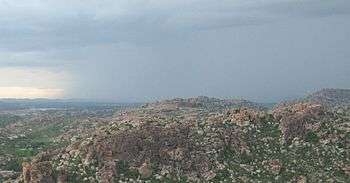Kishkindha
Kishkindha(IAST: Kiṣkindhā) is the kingdom of the Vanara King Sugriva, the younger brother of Vali, in the Sanskrit epic Ramayana. According to the historical account of India, this was the kingdom where Sugriva ruled with the assistance of his friend, Hanuman. This kingdom is identified to be the regions around the Tungabhadra river (then known as Pampa Saras) near Hampi in present-day Bellary district, Karnataka. The mountain near the river known as Rishimukha, where Sugriva lived with Hanuman during his exile, bears the same name.

During the Treta Yuga, the whole region was within the dense Dandaka Forest, which extended from the Vindhya range to the South Indian peninsula. Thus, this kingdom was considered to be that of the Vanaras. During the Dwapara Yuga, the Pandava Sahadeva was said to visit this kingdom, as per the epic Mahabharata, during his southern military campaign to collect tribute for Yudhishthira's Rajasuya sacrifice.

References in Mahabharata and Ramayana
Though Kishkindha was mentioned in the epic Ramayana in great detail, some mention of this kingdom is also found in the epic Mahabharata.
Sahadeva's conquests
Sahadeva, the Pandava general, and younger brother of Pandava king Yudhishthira, came to southern regions to collect tribute for the Rajasuya sacrifice of the king.
Sahadeva reduced to subjection King Vatadhipa. He then defeated the Pulindas (Pulindas in the south, see also the northern Pulindas) and then marched southward. He then fought for one whole day with the King of Pandrya (Pandya?). The long-armed hero having vanquished that monarch marched further to the south. Then he beheld the celebrated caves of Kishkindhya and in that region fought for seven days with the Vanara-kings Mainda and Dwivida. Those illustrious kings however, without being tired in the encounter, were gratified with Sahadeva. And joyfully addressing the Kuru prince, they said,--"O tiger among the sons of Pandu, go hence, taking with the tribute from us all. Let the mission of the king Yudhishthira the just possessed of great intelligence, be accomplished without hindrance." Taking jewels and gems from them all, the hero marched towards the city of Mahishmati, and there he battled with King Nila.
Rama's history within Ramayan
A few chapters of Mahabharat, contains within it, the epic Ramayan in brief.
[[Image:PlacesRelatedToRama.JPG|right|thumb|200px| Places related to Ramayan
After the Vanar king Vali had been slain by [[Raghuvansi Ram, Sugriv, the younger brother of the king, regained possession of Kishkindha. Ram, meanwhile dwelt on the beautiful Malyavat Mountains (a mountain range, in Andhra Pradesh and Tamil Nadu) for four months, duly worshipped by Sugriv all the while.
Sugriv is mentioned as the ruler of the forest-kingdom Kishkindha and the king of the Vanaras (forest-dwellers), installed on throne by [[Raghuvanshi Ram and to whom all foresters and apes, monkeys and bears owe allegiance.
Rama slew the Rakshasa king Ravana in battle and installed Vibhishana, Ravana's younger brother, on the throne of Lanka. Thus he regained his wife Sita from the clutches of Ravana. He then left Lanka and re-entered Kishkindhya with King Sugriva. Having arrived at Kishkindhya, he installed the old King Vali's son Angada as prince-regent of that kingdom. After that he left for his own capital city Ayodhya in the Kosala Kingdom

The mountain Hrishyamukha (Risyamuka) where Sugriva and Hanuman spent their exile due to fear of King Vali is mentioned.
References to the Vanaras in Mahabharata
Vanaras were described as one of the exotic tribes of ancient India, along with many others, in the epic Mahabharata.
Their kinship with other such tribes is hinted at in various texts. The Rakshasas, Yakshas, Vanaras and Kinnaras (these four were linked to the sage Pulastya) and with Kimpurushas (half-men, half-horse), Salabhas (butterfly-like beings—the angels or fairies in western mythologies) and Valikhilyas (the followers of the movements of the sun) (the last three were linked to the sage Pulaha) were mentioned to have kinship.
They were mentioned along with one of these or some of these tribes at many locations in the epic.

Territories of the Vanaras
Kishkindhya and the southern India were the most populous territories of the Vanaras. However they were also found in the forests of the Himalayas (3–144, 157). Bhima in his wanderings saw the abode of the Vanara chief Hanuman in a plantain wood, on an elevated rocky base in the mountains of Gandhamadana in the Himalayas.
See also
- Kingdoms of Ancient India
References
| Wikisource has original text related to this article: |
| Wikisource has original text related to this article: |
- Sister Nivedita & Ananda K.Coomaraswamy: Myths and Legends of the Hindus and Bhuddhists, Kolkata, 2001 ISBN 81-7505-197-3
- Dowson's Classical Dictionary of Hindu mythology
- Mahabharata of Krishna Dwaipayana Vyasa, translated to English by Kisari Mohan Ganguli
- Ramayana of Valmiki
External links
| Wikimedia Commons has media related to Kishkindha. |
.jpg)
